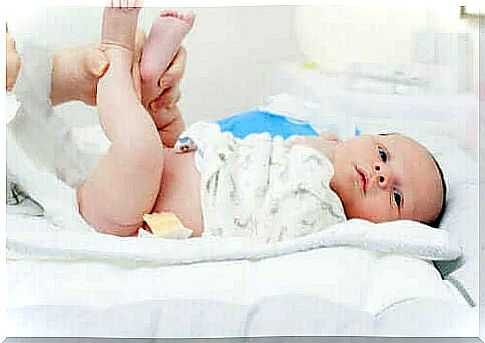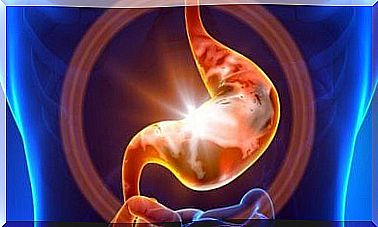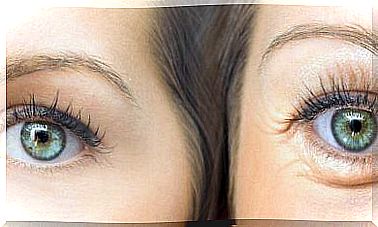Sacred Dimples And How They Affect Children

Some babies have a small notch, called a dimple, in the lumbar area, also known as the sacral area. The sacrum is a bone that lies in this area. Read more about sacral dimples in babies here.
The sacral dimple can be a simple spot that does not cause any discomfort. However, sometimes this dimple connects to the spinal canal and can cause problems in the nervous system.
Today’s article describes it in detail and also discusses its treatment.
What is a sacral dimple?
As mentioned above, a sacral dimple is an indentation or dimple in the lower back. It is present from birth. It is usually located just above the buttock fold.
Most of these dimples are harmless, but a significant percentage are associated with spinal dysraphia. According to an article in Acta Pediátrica (Spanish link), this refers to certain birth defects that cause incomplete closure of certain structures, such as the spine.
It is a heterogeneous group of malformations that expose the neural tissue. The same study states that between 40 and 95% of babies with spinal dysraphia have some kind of skin abnormality. In many of these cases it is a sacred dimple.
In particular, assume that the sacral dimple is severe if it is close to a tuft of hair or if there are color changes in the skin immediately surrounding it. The problem is that complications can arise in these cases, such as:
- neurological
- urinary tract problems
- rectal
- orthopedic
That is why it is essential to be able to distinguish it, to detect it and to treat it.
Types of Sacred Dimples
A sacral dimple can be typical or atypical. It is this simple distinction that makes it possible to tell the difference between a benign situation and something serious. A typical or simple sacral dimple is small and located in the crease between the buttocks.
These are usually less than 5mm in diameter and are located close to the edge of the anus. They are quite common and do not pose a risk of dysraphia. Estimates indicate that nearly 5% of healthy newborns have them.
In contrast, there are atypical dimples that are larger, more than half an inch deep, and further away from the anus. They can even be located on the sides.
An atypical dimple is a risk factor for spinal dysraphia. Also, there may be abnormal communication with the spinal canal if the dimple is too deep. The spinal canal is a sensitive structure through which numerous nerve fibers run.
This communication can thus lead to spinal and neurological damage. Also, this type of dimple can be accompanied by changes in skin color, lumps, and there may even be areas of unusual hair growth.
The difference between a sacral dimple and a pilonidal cyst
A ciliary cyst contains hair formations within (Spanish link). Similar to a sacral dimple, it occurs in the intergluteal region, just above the buttocks.
In the hair nest cyst, hair, cells, waste products and fluid accumulate, creating a collection. The cyst usually develops after birth, is more common in males, and often becomes infected. The result is severe pain and swelling.
Causes of Sacred Dimples
The causes of sacral dimples are not yet known, but we know it is congenital. This makes it possible to distinguish it from the pilus cyst, as we mentioned above.
Atypical dimples may result from this defect in the closure of midline structures. However, we don’t know why this is happening.
Symptoms and Diagnosis

In general, a sacral dimple is asymptomatic. That’s because it’s just a dimple, a cutaneous change in the lower back.
However, atypical sacral dimples usually have symptoms that depend on whether it is due to spinal dysraphia. A doctor should do a thorough physical exam to detect it.
He usually measures and checks the characteristics of the dimple and must do a series of additional tests if it is too large or too deep. The same applies if there are more dimples, if the skin is discolored, or if it is too far from the anus.
According to a study published in Archives of Disease in Childhood , ultrasound is a method of studying dimples. According to estimates, the chance of a spinal problem is six times greater if there are abnormalities.
Ultrasound is a preferred technique because it is fast, safe and inexpensive. However, if in doubt about the diagnosis, an MRI can always be made. This is because it is a closer examination of the tissues.
Possible complications
Atypical dimples have more complications and can be related to spina bifida or spina bifida, or tethered cord syndrome, among other things.
Spina bifida is a congenital malformation. What happens is that the neural tube doesn’t close properly. There are several varieties, but the one associated with the sacral dimple is spina bifida.
The main feature is a small opening in the spine that arises because the spine has not developed. It can be asymptomatic and is usually discovered during adolescence or adulthood.
Tethered cord syndrome occurs when scar tissue anchors the spinal cord. It can lead to urinary and faecal incontinence, weakness in the lower extremities and even difficulty standing up.
Treatment of sacral dimples
There is no treatment for a simple sacral dimple, and there is no need for it. All you have to do is prevent dirt from building up in the area to prevent infections. This is because the dimple is too close to the anus and intestinal bacteria can contaminate it.
That’s why it’s essential to clean this area of a baby well, especially when you’re changing the diapers. An atypical dimple may require treatment, depending on its severity.

The procedure depends on the stage of the sacral dimple
Ideally, all newborns should be thoroughly examined by a physician and they should conduct an examination for a sacral dimple if they find one. It consists of measuring the dimple along with other deviations.
The child should be in good health if everything else is normal and the sacral dimple is small. However, if the dimple is atypical or if there are other warning signs, the baby will need a specialist.
Doctors should carefully examine a dimple to determine if there are any neurological or developmental abnormalities. Also, the best treatment for a particular case should be considered depending on specific results.
Remember that most sacral dimples are harmless and are just a skin change. However, you should see a doctor and rule out a neurological problem.









